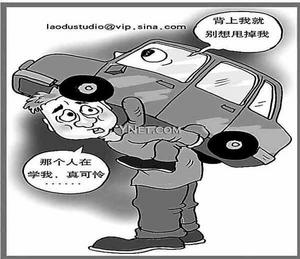| 北京不要变成洛杉矶 |
| http://www.sina.com.cn 2003/11/13 09:44 北京青年报 |
 In pursuit of modernization the Beijing municipal government is widening roads, building freeways and encouraging the purchase of personal cars. I would like to give the city I love a heartfelt suggestion: Beijing should avoid adopting America's reliance on cars and freeways, which has been the greatest mistake in America's urban development in the last century. If Beijing continues to add roads and promote private ownership of cars, future generations will regret this almost irreversible choice, as many Americans do today. I am a Yale student who lived in Beijing a few years ago; I hope my opinion will be helpful in improving the city's traffic flow and transportation system for the 2008 Olympics. I grew up near Los Angeles in southern California, a region strangled by highways, the blight of American cities and the landscape. When I was in Los Angeles a few months ago, I noted that more than 75% of the ground was covered in pavement or asphalt roads and parking lots. The city is designed on the scale of cars and not people, making it inconvenient to walk almost anywhere. It is common for Angelenos to spend two hours commuting to work and school every day. Those who can't drive are the most marginalized -- the poor who cannot afford cars, children who are isolated in suburban enclaves, and the elderly. Recently an old man crashedsintosan outdoor market in Los Angeles, killing 10 people. America's lack of public transportation means that when the elderly cannot drive, they cannot even go shopping. How did Los Angeles and many other American cities become oceans of asphalt,swheresno one can buy a sandwich without using a car? A combination of factors: government subsidization of roads and highways more than public transportation, powerful auto, oil and tire corporations, and a culture that glamorized the automobile. Beginning in the 1930s, dozens of American cities, including Los Angeles, sold off their trolley systems, while government poured moneysintosroad construction. Then at the height of the Cold War in the 1950s and 1960s, the US government made the misguided decision to build highways as a defense strategy, assuming suburbanization would protect the nation from catastrophic loss of life in the event of nuclear war. Rightsintosthe 1980s Los Angeles widened roads in an effort to relieve traffic congestion. Unfortunately, city planners learned too late that the wider the roads were, the farther apart major buildings became, and thus the farther people had to drive. It may seem counterintuitive①to Beijingers today, but American urbanists now recognize that traffic expands to fill the roads. The effect of car-reliant transportation systems on cities is "urban sprawl" -- undesirable horizontal rather than vertical growth. America's most livable cities are San Francisco, Boston and New York, which not coincidentally are among the few American cities with high urban density and good public transportation as well as good parks②. Reliance on cars is bad for society, the economy and the environment. In American suburbs the young, the elderly and the poor lack mobility. Time is wasted in driving cars, material resources in producing them. Too many cars and highways are bad for the environment because they cause low-density development to take over land, degrading natural areas and using land inefficiently. The nation's economic dependence on petroleum is a severe problem caused by our individual dependence on cars. China should learn from the mistakes of the United States. Study the high-speed trains spanning France and the subways of London, Paris, Singapore and Tokyo as models of transportation systems. And investigate the promising high-tech Bus Rapid Transit (BRT), which seems to be as efficient as a subway but at 5% the cost to build. Kunming already enjoys BRT③, and Pudong will be building a system soon. If Beijing goes ahead with development based on the automobile, it will be very hard to ensure that urban life there is pleasant. |
| 北京VS洛杉矶:发展汽车和高速公路 |
———美国在发展汽车和高速公路方面的教训 本文作者在1998年至1999年曾住在一个北京人的家庭,并在北京师大二附中上了高三,今年8月她重访北京,她欢迎大家与她就此文观点进行交流。她的Email:april.rabkin@yale.edu 在实现现代化的进程中,北京正在拓宽原有马路,修建高速公路,并且鼓励私人购车。我想我应该为我所喜爱的城市提出一个发自内心的建议:北京应该避免采取美国那种依赖小汽车和高速公路的政策,这已经成为美国上个世纪城市发展中最大的错误。如果北京没完没了地扩路并增加私有轿车,我们的后代将可能像今天的美国人一样后悔这个几乎是无法逆转的选择。作为一个几年前在北京生活过目前在耶鲁大学上学的学生,我希望我的意见会对北京改善城市交通流量和交通体系以迎接2008年的奥运会有所帮助。 我是在美国加州南部的洛杉矶长大的,这个地区已经被高速公路这个给城市与自然景观蒙上阴影的怪物所扼杀了。几个月以前当我又回到洛杉矶时,我发现百分之七十五以上的地面都被人行道、马路和停车场所覆盖了。这个城市是为汽车而不是为人所规划的,如果步行,几乎你去哪里都很不方便。对于洛杉矶人来说,每天在上班或上学的路上花两个小时已是常事。那些不能开车的人最无助,其中有买不起车的穷人,被孤立在郊区“飞地”中的儿童,还有上了年纪的老人。前不久,一位老人因开车失控冲进了洛杉矶的一个露天市场,造成10人死亡。公共交通的缺乏意味着当老人们到了不能开车的时候,连购物都办不到了。 洛杉矶和其他美国城市怎么变成了柏油路的汪洋大海———倘若不开车连买个三明治也做不到?可以说这是几方面原因的综合结果:政府对高速公路的财政补贴政策远多于对公共交通的补贴政策,汽车、汽油和轮胎企业的强大力量以及使得汽车更加诱人的美国“汽车文化”。从上个世纪30年代起,包括洛杉矶在内的十几个美国城市将有轨电车系统私有化,政府则把大量的资金投在了道路建设上。然后,在50年代和60年代冷战高峰时期,美国政府作出了修建高速公路作为防御战略的错误决定,以为城市郊区化可以在一旦发生的核战争中保护国家免受灾难性的人员伤亡。 进入80年代,洛杉矶曾努力拓宽路面以改善交通拥挤。然而,路面越宽,主要建筑的距离就越远,人们就越需要开车,而城市规划者认识到这一点时已经太晚了。有一点对于今天的北京人来说可能与直觉恰恰相反,但在美国城市居住的人们已经认识到了,那就是随着道路的增加,交通流量也越来越大,直至塞满道路。发展依赖于汽车的交通体系的后果是“城市的蔓延”,即城市在令人讨厌的水平方向扩展,而不是在垂直方向上扩展。在美国,最适宜居住的城市是旧金山、波士顿和纽约,它们并非偶然跻身于美国少有的几个不仅有城区密度而且有着良好的公共交通系统和公园绿地的城市。 对于汽车的依赖不利于社会、经济和环境。在美国城郊,儿童、老人和穷人开不了车也就没有了行动的自由;时间浪费在开车途中,材料资源浪费在制造汽车上;过多的汽车和高速公路有害环境,因为它导致的低密度发展占用了大量土地,这样既不能使自然保持原状又不能有效率地使用土地资源。由于美国人对小汽车的依赖,使得美国经济对汽车的依赖成为一个严重的问题。 中国应该从美国的上述错误中吸取教训,并以法国四通八达的高速列车网络以及伦敦、巴黎、新加坡和日本的地铁系统作为城市交通的典范来学习。应对有发展前景的高科技快速公交系统(BRT)进行调研,它的效率像地铁一样高,但建设成本只相当于地铁的百分之五。昆明已经采用了BRT并身受其益,上海浦东也将很快上马。如果北京继续向基于小汽车的交通模式发展,则将很难使得这个都市的未来适宜人们的居住和生活。 |
| 【英语学习论坛】【评论】【大 中 小】【打印】【关闭】 |